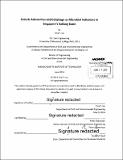Enteric adenovirus and coliphage as microbial indicators in Singapore's Kallang Basin
Author(s)
Liu, Tina Y
DownloadFull printable version (6.780Mb)
Other Contributors
Massachusetts Institute of Technology. Department of Civil and Environmental Engineering.
Advisor
Peter Shanahan.
Terms of use
Metadata
Show full item recordAbstract
E. coli, Enterococci, and other fecal indicator bacteria have been the gold standard for assessing and regulating water quality. However, the presence of these water quality indicators often do not reflect the presence of viral pathogens, such as human enteric viruses, posing significant health risks to the general population. Furthermore, high concentrations of E. coli are often found in tropical environments with no apparent source of fecal contamination. In order to gain comprehensive insight on the recreational water quality of Kallang Basin in Singapore, it is important to establish an understanding of the interactions between pathogens and other microorganisms within the environment. This study focuses on enteric adenovirus and coliphage (F' male-specific and somatic) as potential alternative indicators of fecal contamination. Adenovirus and coliphage concentrations from water samples collected over a 48-hour period were quantified using qPCR assay and cell culture methods, respectively, and analyzed for trends. The presence of viruses was compared to that of E. coli and Enterococci from the same samples. The results from this study suggest significant fecal contamination originating from the tributaries that flow into the Kallang Basin. E. coli and Enterococci concentrations at each station exceeded U.S. EPA regulation standards, however, neither correlated with the presence of adenovirus. Additionally, there was an overall trend of higher concentrations of microorganisms during the first 24-hours of sampling than the second, potentially due to rainfall prior to sampling. The findings from this study emphasize the need for further investigation of pathogenic microorganism to establish effective indices for recreational water quality monitoring in the Kallang Basin.
Description
Thesis: M. Eng., Massachusetts Institute of Technology, Department of Civil and Environmental Engineering, 2014. Cataloged from PDF version of thesis. Includes bibliographical references (pages 36-38).
Date issued
2014Department
Massachusetts Institute of Technology. Department of Civil and Environmental EngineeringPublisher
Massachusetts Institute of Technology
Keywords
Civil and Environmental Engineering.